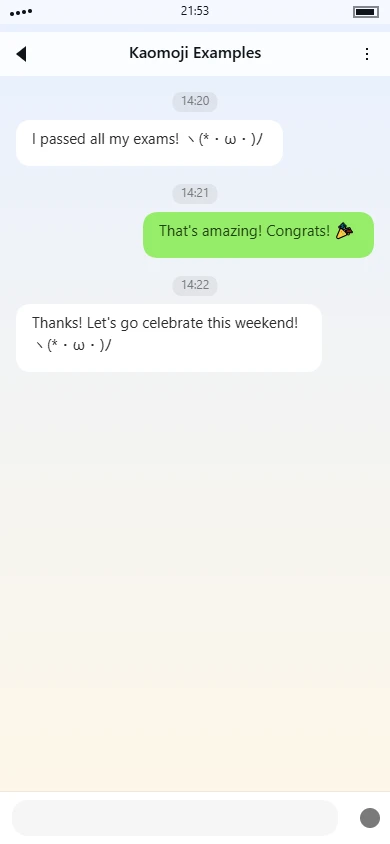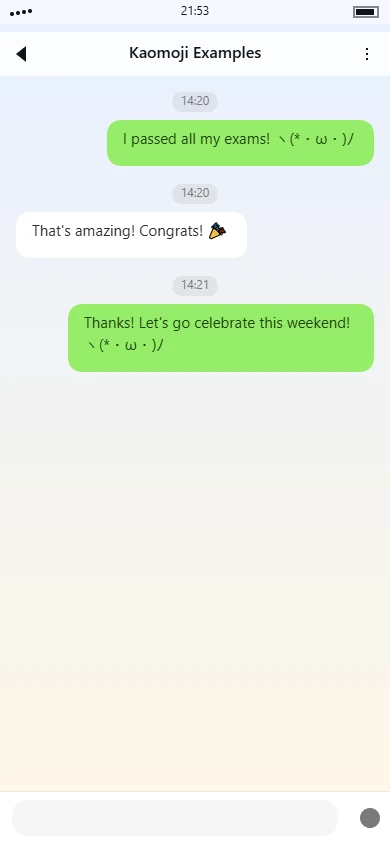(⌒ω⌒) kaomoji Meaning | Usage Tips

Overview
The kaomoji
(⌒ω⌒)Symbol Breakdown
- Parentheses
(
: These symbols form the outer boundary of the face, creating a rounded contour that suggests a soft, friendly appearance. The parentheses help contain the expression within a recognizable facial structure.) - Upper curve
: This character represents the eyes in a closed, smiling position. The curved shape gives the impression of eyes that are gently shut due to happiness, similar to how people squint when genuinely smiling. The use of this specific curved character instead of simple dots or lines adds a distinctive stylistic element.⌒ - Greek letter omega
: Positioned between the eyes, this character serves as the mouth. Its wavy, rounded shape suggests a small, content smile rather than an exaggerated grin. The omega character's flowing curves complement the eye symbols above it, creating visual harmony in the overall composition.ω
Emotion & Aesthetic Analysis
The emotional tone conveyed by
(⌒ω⌒)Visually, the kaomoji exhibits a balanced symmetry with the eyes positioned at equal height and the mouth centered between them. The consistent use of curved lines throughout the composition - in the eyes, mouth, and facial outline - creates a cohesive aesthetic that feels soft and approachable. The overall effect is somewhat reminiscent of a contented cat's expression, which contributes to its occasional association with feline-like contentment in online communication.
In practical usage, this kaomoji appears in contexts where someone wants to express gentle approval, quiet happiness, or satisfied agreement. It might follow a statement of personal contentment, accompany a positive reaction to someone else's message, or serve as a friendly acknowledgment. The expression's restrained nature makes it suitable for situations where more exuberant emoticons might feel excessive, providing a middle ground between neutral and highly enthusiastic responses.
When compared to similar kaomoji,
(⌒ω⌒)(^_^)Tag categories
Use tags to quickly understand this kaomoji.
Usage guide
Usage Guide for (⌒ω⌒)
The kaomoji (⌒ω⌒) is one of the most versatile and widely used Japanese-style emoticons in online communication, representing a contented, happy face with closed eyes and a gentle smile. This emoticon conveys a sense of peaceful satisfaction, warm affection, or quiet amusement—like someone basking in a pleasant moment. Its closed eyes suggest a feeling of comfort and relaxation, making it perfect for expressing gratitude, sharing small joys, or simply adding a touch of warmth to casual conversations. You'll often see it used among friends, in gaming chats, on social media posts, and in comments where a lighthearted, positive tone is desired.
Use Cases
- Sending a thank-you message to a friend who helped you with a task
- Reacting to a cute pet photo shared in a group chat
- Expressing satisfaction after completing a challenging video game level
- Commenting on a relaxing music track or ambient sound video
- Responding to good news from a family member in a private message
- Showing appreciation for a delicious meal picture on social media
- Acknowledging a thoughtful gesture from a coworker in a casual work chat
- Reacting to heartwarming stories or positive updates in online communities
- Expressing contentment while sharing your own relaxing weekend plans
- Adding warmth to a birthday wish or holiday greeting
- Showing gentle amusement at a clever but harmless joke
- Conveying peaceful satisfaction when discussing favorite hobbies
Examples
-
Friend conversation about plans Person A: "I finally booked those concert tickets we wanted!" Person B: "That's amazing! Can't wait (⌒ω⌒)"
-
Gaming community chat Player A: "Just got the rare achievement after 50 tries" Player B: "Congrats! That dedication paid off (⌒ω⌒)"
-
Social media comment Post: "Spent the afternoon reading in the park with my dog" Comment: "That sounds like the perfect day (⌒ω⌒)"
-
Casual work message Colleague: "I brought extra coffee for the team this morning" You: "You're the best, thanks! (⌒ω⌒)"
-
Family group chat Relative: "Made your favorite cookies, will save some for when you visit" You: "You're too kind! Looking forward to it (⌒ω⌒)"
-
Online forum discussion User A: "This new update made the interface so much smoother" User B: "I noticed that too, everything feels better now (⌒ω⌒)"
Notes
- Avoid using this kaomoji in formal business emails, official communications, or serious discussions where a professional tone is required—it may come across as too casual or immature
- While generally positive, the closed eyes can sometimes be misinterpreted as smugness or excessive self-satisfaction in certain contexts, so consider your relationship with the recipient
- This emoticon works best in one-on-one conversations or small group chats rather than large professional meetings or announcements
- The tone is generally warm and gentle rather than excited or enthusiastic—it's more about quiet contentment than loud celebration
- Cultural note: This style of kaomoji originated in Japanese online communities and remains particularly popular in anime, gaming, and tech circles, though it's widely understood across global internet culture
- Platform variation: On Twitter and Discord, you'll often see this used in fandom spaces and gaming communities, while on Instagram it might appear in comments on cozy or aesthetic content
Remember that the best use of (⌒ω⌒) comes from matching its gentle, satisfied energy to appropriate situations where you want to convey warmth without overwhelming excitement.
Usage examples
Real conversation samples that feature this kaomoji.

Example 1

Example 2